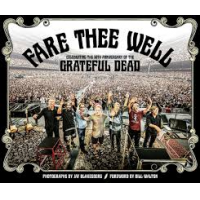Home » Jazz Articles » Book Review » Fare Thee Well: Celebrating the 50th Anniversary of the ...
Fare Thee Well: Celebrating the 50th Anniversary of the Grateful Dead
 Fare Thee Well: Celebrating the 50th Anniversary of the Grateful Dead
Fare Thee Well: Celebrating the 50th Anniversary of the Grateful Dead Jay Blakesberg
208 Pages
ISBN: #0984463089
Rock out Books
2015
Jay Blakesberg's photographic documentary of summer 2015's 'Fare Thee Well' shows "Celebrating Fifty years of the Grateful Dead" is remarkable enough for the nuanced clarity and color his camera(s) captured in Santa Clara and Chicago. But it's actually startling to follow all the shots that fill the 12x10" hardcover book and sense how he's captured the momentum of this sequence of events.
The best shots obviously are those of the musicians in play and they're also the most revelatory. In the early pages of action photos, tension and hesitation come though the somber intensity in the faces of bassist Phil Lesh and guitarist Bob Weir, though no more so than the anticipation verging on anxiety in both the visage and body language of guitarist Trey Anastasio: the pent-up energy within him is increasingly obvious and only slightly dispensed in California the last weekend in June.
But the titular leader of Phish does get his chance to cut loose, vocally and instrumentally, over the Fourth of July weekend. The grins that light up his face and eyes communicate as much of a sense of wonder (that he's actually on stage with some of his role models) as pure delight as he begins to interact smoothly with his bandmates, and his good cheer is obviously infectious as smiles also broaden the wizened visages of Lesh and Weir as they, along with an understated keyboardist/vocalist Bruce Hornsby, unsung hero keyboardist Jeff Chimenti and long-standing rhythm devil drummers Bill Kreutzmann and Mickey Hart, at last begin to bond as one collective unit through the sound they're making.
Such drama is palpable on any stage when improvisational musicians truly unite, but the profundity of this occasion, the last appearance together of the core four of the iconic San Francisco band, alternately heightens and deepens the atmosphere, especially as it moves from the stage out through the audience and back again. Jay Blakesberg, in shooting all over the stage, around it and throughout the venue, takes the reader everywhere through, in, out and around that circular dynamic, so much so that to use a cliché and say it's 'like being there' brings out the truth in the well-worn phrase.
It's possible to feel his exertion in motion as he moves to catch certain angles, anticipate other ones and visualize what the particular photo in process is going to look like . Ultimately out of Blakesberg's device and then on the page, the symmetrical layout of the images comes alive almost like flip animation: the musicians and the audience move as one, then apart then back together again, in a sequence of events similar to the best of the improvisations that happened during the ten sets the band played over the two weekends of five concerts.
It's quite simple to become enraptured with these two-hundred eight pages of brilliant photos because there's little text or captioning to distract in any way: smart editing indeed!. Yet what written content that is here, in the form of an introduction by the author, a foreword from ebullient high-profile Deadhead Bill Walton plus more or less articulate and emotionally insightful essays from archivist David Lemieux and insider author/radio host Gary Lambert, are placed before and after the chronologically sequenced pictures, thus becoming, for all practical purposes, representations for posterity of the anticipation and reflection generated by this heretofore unprecedented event. To say it's all here in Jay Blakesberg's book is a bit hyperbolic, but not by much.
< Previous
Catch and Release
Next >
Catch And Release
Comments
About Grateful Dead
Instrument: Band / ensemble / orchestra
Related Articles | Concerts | Albums | Photos | Similar ToTags
For the Love of Jazz
 All About Jazz has been a pillar of jazz since 1995, championing it as an art form and, more importantly, supporting the musicians who create it. Our enduring commitment has made "AAJ" one of the most culturally important websites of its kind, read by hundreds of thousands of fans, musicians and industry figures every month.
All About Jazz has been a pillar of jazz since 1995, championing it as an art form and, more importantly, supporting the musicians who create it. Our enduring commitment has made "AAJ" one of the most culturally important websites of its kind, read by hundreds of thousands of fans, musicians and industry figures every month.























